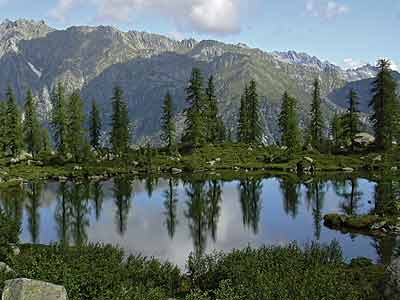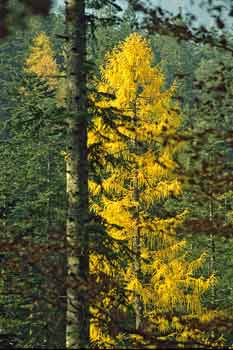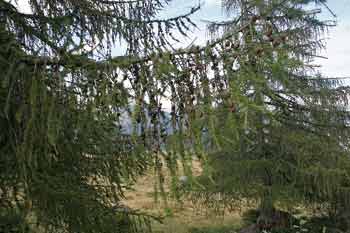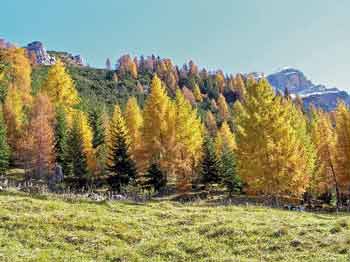| |
THE LARCH: legend and therapeutic properties
Carlo Signorini
 One day in late autumn I found myself strolling though the woods where most of the trees are firs. Every now and then you can also catch a glimpse of a larch, which can be seen from afar amidst the greenery of its companions. Only a few needles in an earth-like colour remained on its branches. The plant has a regal air but without haughtiness. In autumn it sheds its needle-like leaves presenting them to Mother Earth for her to transform them into useful substances and nutriment for the future.Before freeing itself of its needles, the larch turns into a blaze of bright colours that, beginning with green, turn to yellow then brown with shades of red and finally to gold. As these plants are able to reach gigantic proportions, the multitude of its colours also follows suit. According to a popular saying in these mountains, it will not snow until the larch looses most of its needles and its leaves must remain in contact with the earth under and not above the snow. At the first signs of an imminent snowfall, the plant has a lot to do to shed all its leaves in a hurry. When walking through the woods under these circumstances, you will find yourself in the middle of a fully-fledged snowfall of small soft needles.In these woods mostly made up of fir trees, I raise my eyes and see the bare tops of my larch friends that look like Franciscan monks in their well-worn brown cowls. They are ancient figures, taken little into consideration in the frenetic concept of modern life. It makes me smile to think that as an individual I too am "outdated". A bearded old man with a thin, white head of hair; a herborist, a magician and a researcher of Nature's secrets is now not of much use. Up until one or two generations ago, the larch was the king of the woods, its tender foliage let the sun's rays seep through, so that there is also a place for animals to graze. In autumn, its fallen needles were gathered to make the "starlet": bedding for cows in the stalls. On days with strong wind, the larch lets its larger and older branches fall off. It was not difficult to gather firewood, which was considered by far the One day in late autumn I found myself strolling though the woods where most of the trees are firs. Every now and then you can also catch a glimpse of a larch, which can be seen from afar amidst the greenery of its companions. Only a few needles in an earth-like colour remained on its branches. The plant has a regal air but without haughtiness. In autumn it sheds its needle-like leaves presenting them to Mother Earth for her to transform them into useful substances and nutriment for the future.Before freeing itself of its needles, the larch turns into a blaze of bright colours that, beginning with green, turn to yellow then brown with shades of red and finally to gold. As these plants are able to reach gigantic proportions, the multitude of its colours also follows suit. According to a popular saying in these mountains, it will not snow until the larch looses most of its needles and its leaves must remain in contact with the earth under and not above the snow. At the first signs of an imminent snowfall, the plant has a lot to do to shed all its leaves in a hurry. When walking through the woods under these circumstances, you will find yourself in the middle of a fully-fledged snowfall of small soft needles.In these woods mostly made up of fir trees, I raise my eyes and see the bare tops of my larch friends that look like Franciscan monks in their well-worn brown cowls. They are ancient figures, taken little into consideration in the frenetic concept of modern life. It makes me smile to think that as an individual I too am "outdated". A bearded old man with a thin, white head of hair; a herborist, a magician and a researcher of Nature's secrets is now not of much use. Up until one or two generations ago, the larch was the king of the woods, its tender foliage let the sun's rays seep through, so that there is also a place for animals to graze. In autumn, its fallen needles were gathered to make the "starlet": bedding for cows in the stalls. On days with strong wind, the larch lets its larger and older branches fall off. It was not difficult to gather firewood, which was considered by far the best. Using its smaller and thinner branches the elderly tied them together to prepare small bunches that were used to light the fire in the stove, quickly and easily. At the foot of the best specimens, a hole was drilled in the trunk which remained plugged throughout the year; during the summer collectors of "Largà” (larch resin) would pass by. In the hottest season, they unplugged the holes in the larches and, using a special tool made like a long spatula with an auger, they let the resin with a honey consistency pour from the hole into special wooden buckets. There was not a house or a family that did not have a container with ” "Largà"; it was the infallible remedy to extract any foreign body stuck under skin of people or animals. The evening before bedtime, "Largà” was generously spread over the area where the splinter was stuck and bandaged. During the night the foreign body was slowly pulled out by the "Largà", which was an excellent disinfectant and inflammation reducer. Packs of it were also used against rheumatic pains, inflammation of the respiratory tract and as an "ager” for pimples and boils to extract the pus inside. Most of the resin collected during the summer was filtered with special large sieves to separate it from the remaining minute impurities and sent far away to the refineries. There it was distilled to obtain a variety of products: turpentine essential oil, white spirit and, lastly, pitch. Pitch was an indispensable tar spread on the wooden hulls of boats and ships to make them waterproof and rot-resistant. best. Using its smaller and thinner branches the elderly tied them together to prepare small bunches that were used to light the fire in the stove, quickly and easily. At the foot of the best specimens, a hole was drilled in the trunk which remained plugged throughout the year; during the summer collectors of "Largà” (larch resin) would pass by. In the hottest season, they unplugged the holes in the larches and, using a special tool made like a long spatula with an auger, they let the resin with a honey consistency pour from the hole into special wooden buckets. There was not a house or a family that did not have a container with ” "Largà"; it was the infallible remedy to extract any foreign body stuck under skin of people or animals. The evening before bedtime, "Largà” was generously spread over the area where the splinter was stuck and bandaged. During the night the foreign body was slowly pulled out by the "Largà", which was an excellent disinfectant and inflammation reducer. Packs of it were also used against rheumatic pains, inflammation of the respiratory tract and as an "ager” for pimples and boils to extract the pus inside. Most of the resin collected during the summer was filtered with special large sieves to separate it from the remaining minute impurities and sent far away to the refineries. There it was distilled to obtain a variety of products: turpentine essential oil, white spirit and, lastly, pitch. Pitch was an indispensable tar spread on the wooden hulls of boats and ships to make them waterproof and rot-resistant.
It was once used in the manufacture of fine musical instruments made with music wood and also to strengthen cords and string made of vegetal fibres in addition to many other uses. The larch with its resin provided an indispensable product for the pace of life at the time: it was Green Gold! Nowadays all these products are obtained from Black Gold, but are they truly the same? The wood of the larch tree was invaluable, heavy and resistant, but its principal characteristic was and is its water and weather resistance capability; for all practical purposes, it does not rot. In work tools made of wood the parts subjected to the most wear were manufactured with larch wood. This is why my impression is that of a figure now outdated; its noble qualities that set the pace and existence of many generations of mountain people are now no longer appreciated. New synthetic products are preferred in their place that are often harmful to man and the environment. The way I see it the larch simultaneously contains both feminine and masculine energy. Without a doubt, its virile figure rising into the sky brings to mind a male phallus, like the strength of its wood that provided weapons as strong as steel when toughened by fire. On  the other hand, its foliage that lets sunlight seep through for smaller forms of life is feminine, as is its lack of haughtiness when it is stripped of its leaves, her generosity and the charming feminine "frivolity” of often changing clothes. The magic energy of the larch lies in its ability to bring to the surface and reveal the deepest, most intimate and most subtle sides of the human soul. They may be past traumas, emotions, hidden feelings, spiritual quest; anything that lies hidden in our subconscious, which, in the long term, may torment and damage our existence. Whereas, once it is externalized and taken into consideration, it matures and slowly dissolves into its most impetuous part enriching life. To those who wish to experience this, I recommend they wear talismans in contact with their body made of larch wood or parts of the plant. Another practice that I recommend is to embrace one of these gigantic creatures for a long time to evoke its spirit.The mountains were a land where legends linked to magic and mystery easily sprung up. In a place not far from where I live, there is a marvellous legend that explains the birth of the larch. A silver stream once flowed through an enchanted valley inhabited by Aguanas, aquatic creatures with magical powers. A beautiful princess, daughter of the Lord and an Aguana, lived in the castle. Her name was: Marugiana. The Princess had acquired magical powers from her mother: she was able to foresee in advance the tragedies and misadventures that befelled her people. One day a young knight passed by the stream and, as in all the best stories, the young couple fell in love and decided to marry. She expressed the desire that on the day of their marriage, pain and evil, if only for a brief moment, disappear from the Earth. The sages of the region conferred with each other, but were unable to find a solution. It was then that an old Aguana said: the other hand, its foliage that lets sunlight seep through for smaller forms of life is feminine, as is its lack of haughtiness when it is stripped of its leaves, her generosity and the charming feminine "frivolity” of often changing clothes. The magic energy of the larch lies in its ability to bring to the surface and reveal the deepest, most intimate and most subtle sides of the human soul. They may be past traumas, emotions, hidden feelings, spiritual quest; anything that lies hidden in our subconscious, which, in the long term, may torment and damage our existence. Whereas, once it is externalized and taken into consideration, it matures and slowly dissolves into its most impetuous part enriching life. To those who wish to experience this, I recommend they wear talismans in contact with their body made of larch wood or parts of the plant. Another practice that I recommend is to embrace one of these gigantic creatures for a long time to evoke its spirit.The mountains were a land where legends linked to magic and mystery easily sprung up. In a place not far from where I live, there is a marvellous legend that explains the birth of the larch. A silver stream once flowed through an enchanted valley inhabited by Aguanas, aquatic creatures with magical powers. A beautiful princess, daughter of the Lord and an Aguana, lived in the castle. Her name was: Marugiana. The Princess had acquired magical powers from her mother: she was able to foresee in advance the tragedies and misadventures that befelled her people. One day a young knight passed by the stream and, as in all the best stories, the young couple fell in love and decided to marry. She expressed the desire that on the day of their marriage, pain and evil, if only for a brief moment, disappear from the Earth. The sages of the region conferred with each other, but were unable to find a solution. It was then that an old Aguana said:
There is a moment in time when everything appears to standstill in an unreal peace. This happens every one-hundred years and the favourable moment falls this year. At noon precisely, on the day of St. John the Baptist, all this will come to pass.
So the wedding ceremony was organised for that special moment, and the marriage of the young couple was celebrated in an enchanting atmosphere. enchanting atmosphere.
Two ingenious Dwarfs decided to make one large bouquet with all the flowers of the feast day. The resulting bouquet of flowers turned out to be large as a tree and they planted it in a meadow and named it Lares, in honour of the genies of the hearth. It was beautiful to look at, but everyone knew that the large bouquet of flowers would not survive in the bitterly cold environment of mountain winters. In order to protect it from the bad weather, Princess Marugiana threw her wedding veil over the huge bouquet and, as if by magic, green shoots emerged and later flowered into fragrant red cones.Everyone was stupefied by the larch's beauty, which from that day onwards became the symbol of marriage; as a matter of fact, like marriage, the larch is green and flowers in the spring. It is red and gold in maturity, but, in the winter, if Marugiana does not cover it with her veil of love, it becomes bare and dry.
|
|